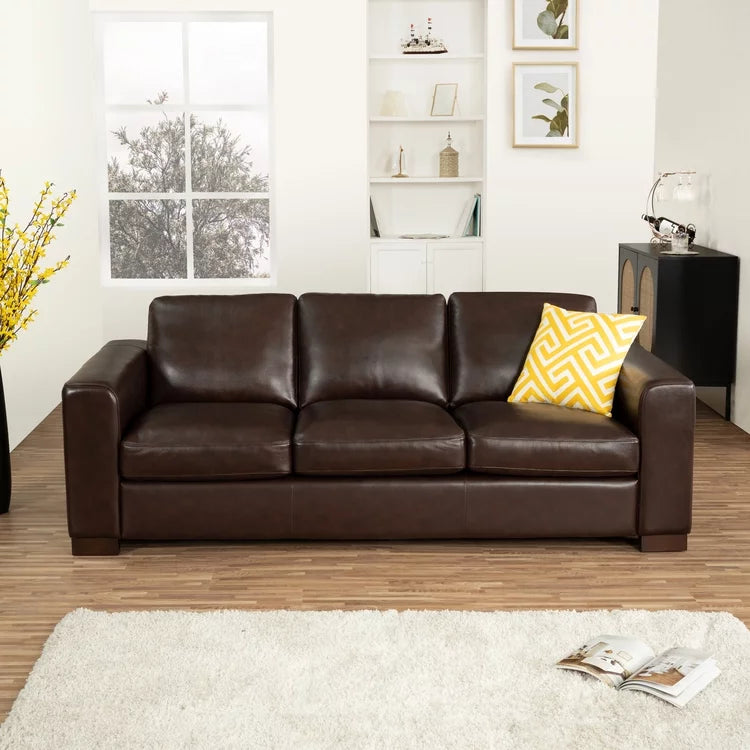In this guide, we will explore everything you need to know about bonded leather sofas, which have gained significant popularity in the world of furniture. These sofas offer a compelling blend of style and affordability, making them an appealing choice for many homeowners.
Throughout this guide, we will discuss the features, advantages, and factors to consider when purchasing a bonded leather sofa. Whether you're looking to enhance your living space or seeking a reliable and budget-friendly seating option, understanding the ins and outs of the material sofas will help you make an informed decision.
What Is A Bonded Leather Sofa?
While leather lounges can be expensive, bonded leather provides a more economical option. Unlike higher quality leather products made from a single hide, bonded leather is made from collected cutoffs and smaller pieces. These remnants are taken to a specialized factory where they are ground together and mixed with polyurethane.

Bonded leather offers an economical alternative to expensive leather lounges.
The result is a leather product that not only looks but also smells like genuine leather. Distinguishing a bonded leather sofa from one made of real cut leather can be challenging for the average consumer. This manufacturing process enables bonded leather to offer a cost-effective alternative without compromising on appearance or texture.
How To Identify Quality Bonded Leather Sofas
Labeling
Labeling
Start by checking the product label. Genuine leather manufacturers proudly display terms like full grain leather, top grain leather, crazy horse leather, 100% leather, or genuine leather.
These indicate high-quality, real leather. However, vague terms such as composite leather, reconstituted leather, recycled leather, mixed leather, or glued leather suggest a lower amount of genuine leather. Additionally, the absence of any label might indicate PU leather or other synthetic materials.
Texture
Bonded leather exhibits a flawless, uniform, and smooth appearance. Natural leather, however, displays imperfections, similar to our skin. Full grain leather, known as the best quality, retains its natural imperfections and develops a beautiful patina over time.

Bonded leather showcases a flawless, uniform, and smooth appearance, offering an aesthetically pleasing surface that appeals to many.
Top grain leather and genuine leather, while smoother than full grain, still possess some imperfections. Bonded leather's perfectly smooth surface can make it challenging to distinguish from grain corrected leather or lower-quality genuine leather.
Touch
Bonded leather has a less responsive, almost dead surface. It maintains its shape and doesn't deform easily. In contrast, genuine leather stretches, wrinkles, and forms marks with ease, although these marks are typically temporary.
Smell
Genuine leather carries a distinct, organic scent that evokes memories. While bonded leather may have a slight background of natural leather smell due to its composition, artificial reproduction of the genuine leather scent is difficult.
Manufacturers often add scents to mimic it but chemical, plastic, or petroleum odors may also be present. In some cases, treated bonded leather might lack any discernible smell.
Cost
One significant difference between artificial leather and genuine leather is the price. Bonded leather, which contains more artificial materials, is considerably cheaper due to the use of lower-cost raw materials compared to genuine leather. If a leather product seems too good of a bargain, it's likely not authentic.
Pros & Cons of Bonded Leather Sofa
Pros
Pros
Bonded Leather Quality: Bonded leather, with its blend of genuine and synthetic leather, offers an affordable alternative to real leather. Comprising no more than 20% natural leather, it is considerably cheaper, while still imparting a vintage style and a touch of luxury to your attire.

Bonded leather provides an affordable alternative to genuine leather, blending both genuine and synthetic leather.
Unlike natural leather, bonded leather undergoes a controlled manufacturing process, resulting in a uniform and smooth appearance. This sets it apart from natural leather, which may exhibit traces, veins, or scratches inherent to the animal's life.
Additionally, the manufacturing process allows for extensive customization, with options for various colors, textures, and patterns, catering to individual preferences and requirements.
Moreover, bonded leather contributes to the circular economy by utilizing and repurposing leather scraps and leftovers from tanneries, which would otherwise be discarded. This eco-friendly aspect, coupled with the efficiency of its artificial plate-like form, minimizes waste and maximizes cutting efficiency.
Cons
It's important to consider the durability and lifespan of bonded leather compared to real leather. Bonded leather, being less robust and sturdy, does not have the same longevity as genuine leather. It may require repairs or even replacement, whereas high-quality real leather, like full grain or crazy horse leather, can last approximately four times longer on average.
Repairing bonded leather poses more challenges compared to real leather, often resulting in ongoing degradation despite attempts at maintenance and repairs. Due to its limited flexibility and responsiveness, bonded leather is prone to easy damage, resulting in scratches and peeling. In contrast, genuine leather develops a beautiful patina over time, enhancing its aesthetic appeal.
Furthermore, bonded leather is not an organic material and lacks breathability, which can cause discomfort, particularly in hot weather. Exposure to the sun's UV rays can lead to discoloration in bonded leather, as the dye only penetrates the surface layers of the material. It's important to note that bonded leather contains real leather and is not considered vegan leather, unlike 100% PU leather, which contains no animal matter.
Over time, bonded leather may undergo chemical reactions, potentially leading to the release of chemicals onto clothing or the body. For instance, a low-quality polyethylene coating can emit gases that can be harmful to individuals with respiratory issues.
Bonded Leather Care & Maintenance
Cleaning
Cleaning
Caring for leather products: Cleaning bonded leather requires gentle methods to maintain its finish. Use a damp cloth, preferably a lint-free microfiber one, and lightly wet it to wipe the surface. Ensure the cloth doesn't transfer any color by testing on a small area or a separate bonded leather piece.

Wipe away any remaining dirt from the bonded leather sofa or residue using a damp cloth.
For deeper cleaning, a soft brush can remove dirt with light brushing. Afterward, wipe away remaining dirt with a damp cloth and let the item dry completely before use or storage.
Stubborn stains may require specialized cleaners. Test the cleaner on an inconspicuous area first to avoid discoloration. Use cleaners formulated for bonded leather to treat tougher stains while preserving the surface finish.
Condition
Unlike genuine leather, bonded leather does not require conditioning due to its protective surface finish. This finish acts as a barrier, protecting the underlying leather and preventing the penetration of conditioners.
Cleaning bonded leather is straightforward, thanks to its protective surface. If the protective layer shows signs of wear, applying additional protectants can help restore it. These products can be applied using a cloth, applicator, or sprayed on and wiped off. Always read the instructions provided with the finishes and test them on a small area first to ensure they won't damage the surface.
FAQs
Is Bonded Leather As Good As Real Leather?
Is Bonded Leather As Good As Real Leather?
Bonded leather is not comparable to real leather in terms of quality and durability. Bonded leather is primarily composed of ground leather fibers that are bonded together with a polyurethane mixture. This process creates a material that falls short in comparison to genuine leather.
Real leather offers superior aesthetics, performance, and longevity. It ages gracefully, develops a beautiful patina over time, and can last for many years with proper care. When seeking long-lasting and high-quality leather products, opting for genuine leather is always the recommended choice.
Does Bonded Leather Scratch Easily?
Yes, bonded leather is prone to scratching more easily compared to genuine leather. Due to its composition, which includes a layer of polyurethane over ground leather fibers, the surface of bonded leather is not as resilient as that of genuine leather.
Everyday use, such as friction from sharp objects or pets' claws, can cause scratches and scuffs on bonded leather. These scratches may be more visible and difficult to repair compared to genuine leather, which tends to develop a more desirable patina over time. It is important to handle and care for bonded leather products with caution to minimize the risk of scratches.
How Long will Bonded Leather Last?
Bonded leather sofas have a relatively shorter life expectancy compared to genuine leather sofas. Due to their composition, which includes a significant amount of polyurethane (plastic), bonded leather is more susceptible to cracking and wearing out over time. The polyurethane layer in bonded leather can deteriorate with regular use, resulting in visible signs of wear and cracks.
This process can happen within 2-3 years or even sooner, depending on the level of usage and the quality of the bonded leather product. It is important to be aware of this limitation when considering bonded leather items, as they may require more frequent replacement or repair compared to genuine leather.
Conclusion
It's crucial to understand the different leather sofa classifications. By familiarizing yourself with terms like full grain leather, top grain leather, and genuine leather, you can make more informed choices when selecting a sofa. These classifications represent varying levels of quality and can greatly impact the durability and longevity of your furniture.
For those seeking longevity, quality, and the ability to age beautifully, investing in genuine leather, such as Modern European leather sofas, is recommended. Understanding the differences between bonded leather and genuine leather empowers consumers to make informed decisions when furnishing their homes.




